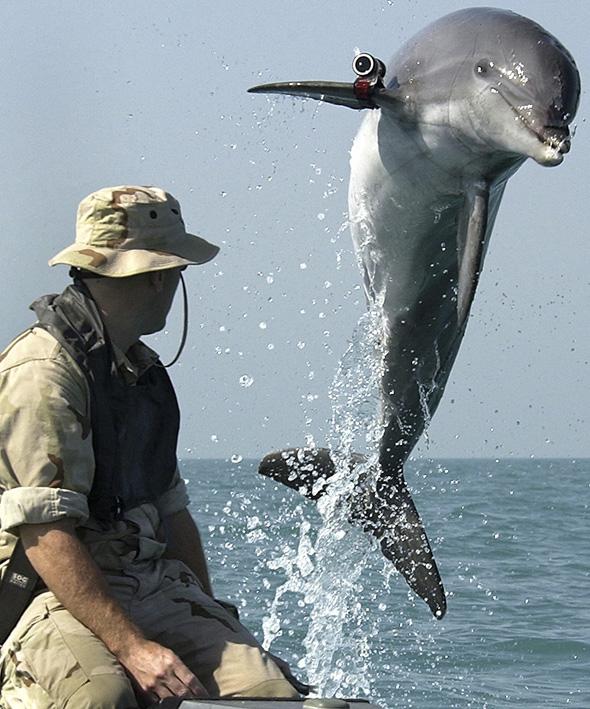On Veterans Day, it’s important to recognize those who have risked life and limb in the name of their country. But being a veteran isn’t a description limited to Homo sapiens. As long as humans have been going to war, animals have been serving alongside them in battle. Horses are the most common compatriots, but others may surprise you—even the humble glow worm has served in its own incandescent uniform. Here are some of the most unusual animals that have aided troops on the battlefield.
Dogs (and one cat)
Canines’ keen senses of smell and hearing have long helped soldiers sniff out bombs and land mines, locate wounded soldiers, and warn of impending attacks. Russian soldiers used sled dogs for transportation, and one American pit bull mix, Sergeant Stubby, was given his sergeant title after attacking a German spy in World War I. But dogs have also been used for less than noble purposes. Before the Civil War, bloodhounds were used to track down runaway slaves, and one (thankfully canceled) project in World War II used dogs to deliver explosives to the enemy.
In 1943, the United Kingdom created the Dickin Medal to award to animals who served in World War II. The majority of the 54 medal recipients were given to dogs and carrier pigeons, but one stalwart cat named Simon was awarded the medal for killing off a nefarious, ration-stealing rat population aboard a British naval ship, even after being injured by a cannon blast that killed 17 of the ship’s crew. Simon and 11 other Dickin Medal recipients are interred at Ilford Animal Cemetery outside London.
Glow worms
In World War I, British soldiers found bioluminescent allies in glow worms. After collecting thousands of worms in jars, soldiers would use them to illuminate messages and maps in the dark trenches. In 2004, the British government honored the glow worms and other military animals with a memorial sculpture bearing an inscription: “This monument is dedicated to all the animals that served and died alongside British and allied forces in wars and campaigns throughout time. They had no choice.”
Elephants
Along with horses and dogs, elephants are some of the earliest animals historically on the battlefield, serving roughly the same role as tanks—Hannibal famously brought more than 30 elephants in his march across the Alps in 218 B.C. Perhaps the oldest of animal veterans is Lin Wang, or Grandpa Lin, an elephant who served in World War II and lived to age 86. After being conscripted by Japanese forces to haul supplies through the Burmese jungle, Lin Wang was captured by the Chinese army and became a double agent. Elephants were also used to ford flooded rivers and may have inspired J.R.R. Tolkien’s oliphaunts in the Lord of the Rings series. The movie Operation Dumbo Drop was based on the true story of a U.S. mission to airlift a pair of elephants to transport lumber through the mountains of Vietnam. (The real name of the mission, Operation Barroom, was a reference to the sound a flatulent elephant makes.)
But pachyderms also did their part outside the theater of war. The British army used roughly 1.2 million horses and mules in World War I, leaving a transportation labor shortage in British towns. Enter Lizzie the elephant, the Rosie the Riveter of the animal kingdom. Lizzie was a traveling circus elephant who was enlisted to haul scrap metal from merchants in Sheffield. She was able to pull the same weight as three horses. Other elephants were put to work on farms plowing fields and hauling crops, and camels were also used to tote heavy loads while horses were away at war.
Dolphins
Like dogs’ keen sense of smell above ground, dolphins’ use of echolocation has been indispensable to U.S. troops in locating underwater mines. The Navy’s Marine Mammal Program has also employed sea lions and seals (not to be confused with Navy SEALs) for their ability to fetch objects from the ocean. The Navy even uses orcas and beluga whales for deep diving expeditions, and sharks and rays for testing the resistance of Kevlar diving suits.
Carrier pigeons
Carrier pigeons aren’t heralded for their loyalty as often as their quadruped counterparts. But one pigeon has earned particular regard for saving almost 200 U.S troops despite being badly injured. Cher Ami, a carrier pigeon donated to the U.S. Signal Corps by Britain, served with the 77th Infantry Division in World War I. Stranded behind enemy lines, the 77th came under friendly fire from unknowing U.S. troops. After the first two pigeons he sent were shot down by German troops, Lt. Colonel Charles Whittlesey wrote one last plea and attached it to Cher Ami’s leg. German troops shot at Cher Ami as he flew away, and despite being blinded, shot in the breast and in the leg, Cher Ami continued his 25-mile journey and successfully delivered Whittlesey’s message: “For heaven’s sake, stop it.” Cher Ami became an American hero, inspiring the writer Harry Webb Farrington to write a poem describing the harrowing flight that cost Cher Ami his leg (“It’s hard a-standing on one leg!” the poem ends). Today, you can visit a taxidermied Cher Ami in the Smithsonian National Museum of American History.
